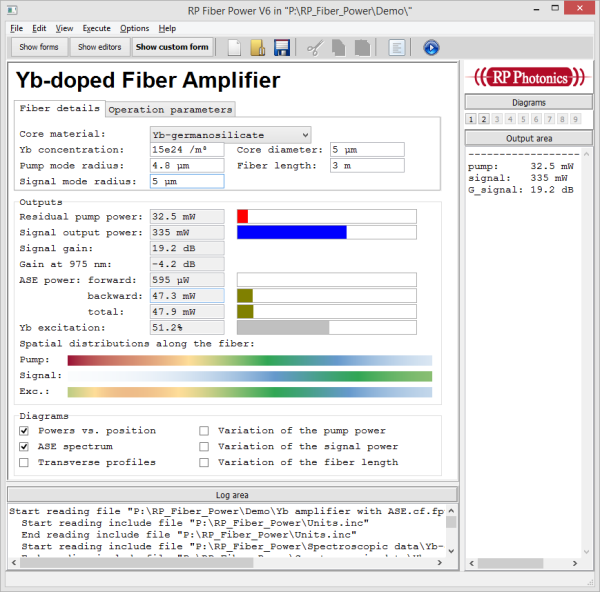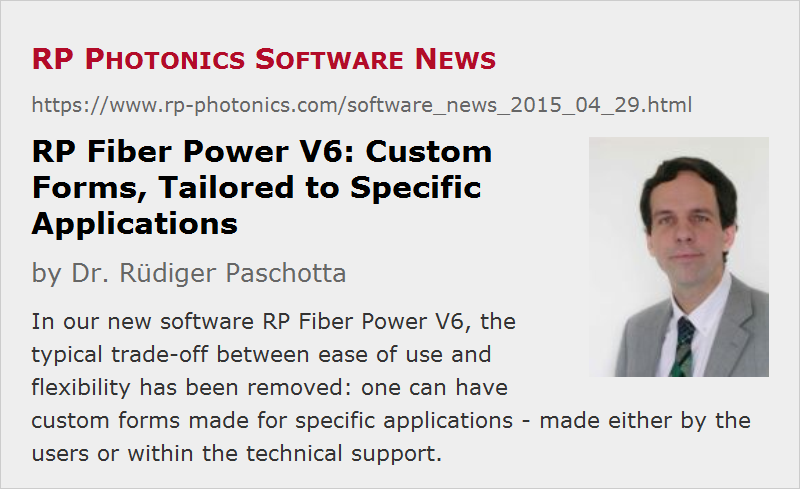RP Fiber Power V6: Custom Forms, Tailored to Specific Applications
Posted on 2015-04-29 in the RP Photonics Software News (available as e-mail newsletter!)
Permanent link: https://www.rp-photonics.com/software_news_2015_04_29.html
Author: Dr. Rüdiger Paschotta, RP Photonics Consulting GmbH
Abstract: In our new software RP Fiber Power V6, the typical trade-off between ease of use and flexibility has been removed: one can have custom forms made for specific applications - made either by the users or within the technical support.

The user interface is an important aspect of a simulation and design software; a good solution really supports the user in the handling of sophisticated things. There are very different concepts for that, having different advantages and limitations. Usually, there is a trade-off between flexibility and ease of use:
- Highest flexibility is achieved by writing script code. Here, the end user can program anything he needs. However, many users feel that learning to develop such script code would be too difficult or at least would need too much time.
- The probably easiest way of using simulation software is having some forms where one can enter all the inputs (e.g., device parameter and operation parameters) and also get the outputs displayed, possibly supplemented with some graphical diagrams. This approach, however, is usually quite restrictive: you can only do what a specific form was made for.
Since RP Fiber Power V2, we have offered a nice combination which somewhat mitigates the explained problem: one can control the most essential calculations with forms, and when executing the calculations, the software automatically writes a script based on the form inputs. As additional snippets of script code can also be injected through the forms, one can actually do a lot without fully switching over to script programming. If the user ever has to do that step, he is strongly supported by the automatically generated script code: one can just start from there rather than from scratch.
Now, with the new RP Fiber Power V6, we have done a further big step forward, introducing so-called custom forms. Such forms are not defined in the software, but rather in scripts. This means that they can be produced by the users themselves, or of course by myself within the technical support. Below, you see an example.

As a result, one now has the combination of two very desirable benefits:
- Ease of use: one can use forms, which can be easily used even by those who do not have the expertise or time to get involved in the technical details. Just fill in the details, and you get the calculated outputs without bothering how exactly this is done.
- Full flexibility: such forms are available for essentially arbitrary calculations, even for the most specialized ones, as they can be custom-designed – either by some colleague or by myself, based on the explanation what exactly is needed.
I think that particularly for many companies, where people need results but cannot spend substantial time, the new custom form feature can be expected to be great news. However, researchers should also appreciate the ease of using such forms. For example, one can easily switch between different sets of input data – for example, for different designs of fiber amplifiers – which are stored in separate text files.
Our web page on custom forms shows examples for the nice look of a custom form, how easy it is to make it, and what convenient features are available.
This article is a posting of the RP Photonics Software News, authored by Dr. Rüdiger Paschotta. You may link to this page, because its location is permanent.
Note that you can also receive the articles in the form of a newsletter or with an RSS feed.
 |

If you like this article, share it with your friends and colleagues, e.g. via social media:
These sharing buttons are implemented in a privacy-friendly way!